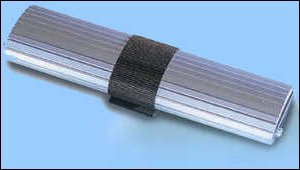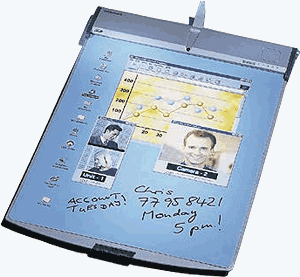Imagine a newspaper that sits neatly in your pocket, is environmentally friendly and gets updated every day. That’s the dream that Toshiba unveiled in early 2000 in the shape of its DynaSheet.

DynaSheet is a concept product that Toshiba believes could become reality by as soon as 2005. Measuring just 1 cm thick and weighing a mere 200g, DynaSheet is a flexible electronic screen that rolls up into a pocket-sized device. At present, the size and shape of a mobile computer is largely dictated by screen format. However, by 2005 the light-emitting polymer (LEP) technology being pioneered by Cambridge Display Technology (CDT) is expected to have led to the development of displays flexible enough to be bent and shaped as required. Continuing with the flexibility theme, by 2005, the development currently under way with lithium polymer gel should have led to batteries that can form any shape required – enabling manufacturers to mould additional power reserves into any free space left over inside the a mobile device’s housing.

By 2005 it will not be uncommon for people to have at least two mobile computing devices, which will be used with a wide variety of peripheral devices. Consequently, all mobile systems will require a reliable and convenient means of exchanging data. One such technology is Bluetooth, an open specification defining wireless data connectivity between electronics devices. Bluetooth-enabled systems will offer an unprecedented level of user-friendliness, thereby encouraging greater integration of computers into our daily lives, be it to exchange e-mail, surf the Web, use online banking services, arrange a visit to the cinema during a video chat with a friend, or simply download the film and watch it at home.
If Moore’s Law continues to hold good, processor clock speeds will have topped 5 GHz by the year 2005. With that kind of power on tap, it is likely that DynaSheet will offer considerable flexibility when it comes to data input – providing a choice between keyboard, stylus or voice input. In addition, tomorrow’s processors will be capable of handling functionality currently provided by other hardware components, such as communications, graphics and audio. A feature of DynaSheet known as context and location sensitivity will make it the ideal mobile companion, capable of acting as a personal navigation system – regardless of mode of transport. As well as recognising streets and buildings, the DynaSheet will be able to supply information on restaurants, shops, businesses and public institutions. Context sensitivity takes that capability one step further, offering smart interactivity based on a range of information sources. If all the necessary enabling technologies continue to progress satisfactorily, the following may not be too fanciful a scenario to imagine by 2005.
You’re walking to work one morning and your DynaSheet checks the diary and notes that you had dinner the previous evening with a business partner. The location system, meanwhile, has reported your visit to a bar on the way back home. As you approach the chemist’s, the system suggests that you stop and buy some headache tablets. When you enter the shop, the system recommends a particular brand, then orders and pays. While this is going on, a video-mail arrives from a colleague in Berlin. Since you have configured the system not to disturb you while shopping, it waits until you are back outside before letting you know the mail has arrived. After sending your reply, you continue on your way!
- Flat panel displays for mobile computers – laptops, notebooks and netbooks
- Battery technology for mobile computers – laptops, notebooks and webbooks
- Laptop, notebook and netbook expansion devices
- Expansion interfaces for laptops, notebooks and other mobile computers
- DynaSheet
- External keyboards for mobile computers.
- USB On-The-Go – USB technology for PDAs and mobile phones
- Guide to Kensington Slot (K-lock, Kensington Lock, Universal Security Lock) mobile device security